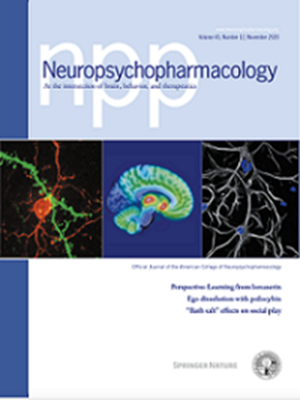Comparing neuromodulation targets to reduce cigarette craving and withdrawal: a randomized clinical trial
IF 6.6
1区 医学
Q1 NEUROSCIENCES
引用次数: 0
Abstract
Cigarette smoking remains the leading preventable cause of death, emphasizing the need for new therapeutics, such as repetitive transcranial magnetic stimulation (TMS). We tested the hypothesis that TMS to three targets would reduce cigarette craving and withdrawal by modulating connectivity within and between three canonical networks in a randomized clinical trial (ClinicalTrials.gov: NCT03827265). Participants (N = 72; DSM-5 tobacco use disorder, ≥1 year of daily smoking) received one session of TMS to hubs of canonical resting-state networks: the dorsolateral prefrontal cortex (dlPFC), superior frontal gyrus (SFG), posterior parietal cortex (PPC), and area v5 (control). Self-reports (craving, withdrawal, and negative affect) and resting-state functional connectivity were measured before and after stimulation. SFG stimulation significantly reduced craving (95% CI, 0.0476–7.9559) and withdrawal (95% CI, 0.9225–8.1063) versus control, with larger effects in men (D = 0.59) than in women (D = 0.30). SFG stimulation did not change network connectivity, whereas dlPFC stimulation increased somatomotor, default mode, and dorsal attention network connectivity. No severe or unexpected treatment-related adverse events occurred. These findings suggest that SFG shows promise as a target for smoking-cessation treatment, especially for men. Further trials are warranted to confirm efficacy and develop imaging biomarkers for precision neuromodulation.

比较神经调节目标减少香烟渴望和戒断:一项随机临床试验。
吸烟仍然是主要的可预防的死亡原因,强调需要新的治疗方法,如重复经颅磁刺激(TMS)。我们在一项随机临床试验中测试了对三个目标的经颅刺激可以通过调节三个典型网络内部和之间的连接来减少对香烟的渴望和戒断的假设(ClinicalTrials.gov: NCT03827265)。参与者(N = 72;DSM-5烟草使用障碍,每天吸烟≥1年)接受一次典型静置状态网络枢纽的经颅磁刺激:背外侧前额叶皮层(dlPFC)、额上回(SFG)、后顶叶皮层(PPC)和v5区(对照)。在刺激前后测量自我报告(渴望、戒断和负面影响)和静息状态功能连通性。与对照组相比,SFG刺激显著减少了渴望(95% CI, 0.0476-7.9559)和戒断(95% CI, 0.9225-8.1063),其中男性(D = 0.59)的效果大于女性(D = 0.30)。SFG刺激没有改变网络连通性,而dlPFC刺激增加了躯体运动、默认模式和背侧注意网络的连通性。未发生严重或意外的治疗相关不良事件。这些发现表明,SFG有望成为戒烟治疗的目标,尤其是对男性而言。需要进一步的试验来确认疗效并开发精确神经调节的成像生物标志物。
本文章由计算机程序翻译,如有差异,请以英文原文为准。
求助全文
约1分钟内获得全文
求助全文
来源期刊

Neuropsychopharmacology
医学-精神病学
CiteScore
15.00
自引率
2.60%
发文量
240
审稿时长
2 months
期刊介绍:
Neuropsychopharmacology is a reputable international scientific journal that serves as the official publication of the American College of Neuropsychopharmacology (ACNP). The journal's primary focus is on research that enhances our knowledge of the brain and behavior, with a particular emphasis on the molecular, cellular, physiological, and psychological aspects of substances that affect the central nervous system (CNS). It also aims to identify new molecular targets for the development of future drugs.
The journal prioritizes original research reports, but it also welcomes mini-reviews and perspectives, which are often solicited by the editorial office. These types of articles provide valuable insights and syntheses of current research trends and future directions in the field of neuroscience and pharmacology.
 求助内容:
求助内容: 应助结果提醒方式:
应助结果提醒方式:


